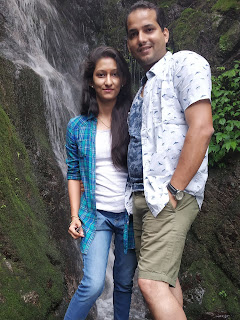Monsoons, Mountains & A Little Madness — Our Dharamshala & Mcleodganj Journey
Shri Keshgarh Sahib Gurudwara
Our first halt on the Chandigarh-to-Dharamshala route was the serene Shri Keshgarh Sahib Gurudwara, one of the five sacred Takhts of Sikhism.
Located near Anandpur Sahib, this holy site is rich in history and perfect for a peaceful break.
Shri Keshgarh Saheb Gurudwara is regarded as one of the five sacred "Takhats" or seats of Sikh religion. It is on the main Rupnagar-Nangal Road and one has to walk a certain distance to reach the shrine, built on the hillock. It was here in 1699, on the Baisakhi day (13th April), Tenth Master Guru Gobind Singh Ji created Khalsa by baptizing five beloved Sikhs known as "Pani Piaras".
Jwalamukhi Temple: The Eternal Flame
Our next stop was the famous Jwalamukhi Temple, one of the 51 Shakti Peethas.
This temple is unique because it houses natural flames instead of an idol, drawing devotees from across the country.
Queues can be long, but the darshan makes everything worth it.
If time permits, you can also visit Shri Bajreshwari Devi Temple, just 3 km from Kangra city.
Dharamshala: A Clean, Serene Himalayan Embrace
By the time we reached Dharamshala—split into Lower Dharamshala and Upper Dharamshala (Mcleodganj)—we were tired yet instantly refreshed by the cool, pine-scented air.
Our stay was at Hotel Pine Valley, a property that ticked all our three essentials: hospitality, food, and location.
Their simple home-style daal chawal revived me after the long road journey—perhaps a little too much, because I definitely overate!
Morning greeted us with a breathtaking green view right from our window. That's the thing about hills—they heal quietly.
St. John in the Wilderness: A Church Lost in Forests
Our first stop of the day was St. John in the Wilderness, a neo-Gothic Anglican church built in 1852 and hidden amidst towering deodar forests.
To reach it, you walk down a stoned path surrounded by thick woods—mystic, peaceful, and picture-perfect.
It’s the kind of place where you can sit for hours without realizing time has passed.
Dal Lake & Naddi Sunset Point: Monsoon in Its Purest Form
A few kilometers away lie two incredibly scenic gems:
🌲 Dal Lake – a small, serene lake nestled among deodars
🌦 Naddi Sunset Point – even magical in the afternoon mist
Our taxi driver tried his best to convince us to skip these “not-so-popular” spots (classic taxi move), but we’re so glad we didn’t listen!
The misty monsoon drama unfolding over the mountains was absolutely soul-stirring.
And yes—don’t you dare leave without trying momos and Maggi at the Naddi tapris.
Pure bliss.
So yes, drenched but happy!.
Namgyal Monastery: Colours, Calm & The Spirit of Tibet
Our last destination for the day was the majestic Namgyal Monastery, the personal monastery of His Holiness the 14th Dalai Lama.
The temple complex is immaculate and peaceful.
This was where I finally learned the meaning of the Tibetan prayer flags I’ve always admired:
Blue – sky
White – air
Red – fire
Green – water
Yellow – Earth
Arranged left to right, they signify harmony and balance.
Large prayer wheels line the temple interiors, and spinning them is believed to have the same merit as chanting “Om Mani Padme Hum.”
The silence here has its own language.
Day 2: Exploring Dharamshala
🏏 Himachal Pradesh Cricket Stadium (HPCS)
One of the world’s highest sports grounds, with a Tibetan-style main pavilion.
The views from the stands will make you believe you’re sitting inside a postcard.
🇮🇳 War Memorial
Located in the middle of a quiet pine forest, the Dharamshala War Memorial honors soldiers who laid down their lives during the 1947–48, 1962, 1965, 1971 operations and peacekeeping missions.
Winding pathways, stone plaques engraved with names, and beautifully designed lawns make this place a thoughtful, emotional stop..
🍃 Kangra Tea Gardens
Stretching across both sides of the Dharamshala–Palampur road, the lush green tea gardens are a soothing visual treat.
Not much to “do,” but so much to feel.
And Finally… A Hidden Beauty of Mcleodganj
Throughout the town, if you observe with a little patience, you’ll notice beautiful murals on the walls—social messages, spiritual motifs, creative splashes of color.
They’re easy to miss, but once you notice them, they stay with you.
---
And That’s a Wrap (For Now…)
With that, our Dharamshala–Mcleodganj trip ended.
We left with full hearts, drenched clothes, overfed stomachs, and memories wrapped in mist and prayer flags.
From here, we headed straight to Dalhousie—a story I’ll share in the next blog..























Very beautifully written... I got full imagination of beautiful scenes there are in Himachal....
ReplyDelete